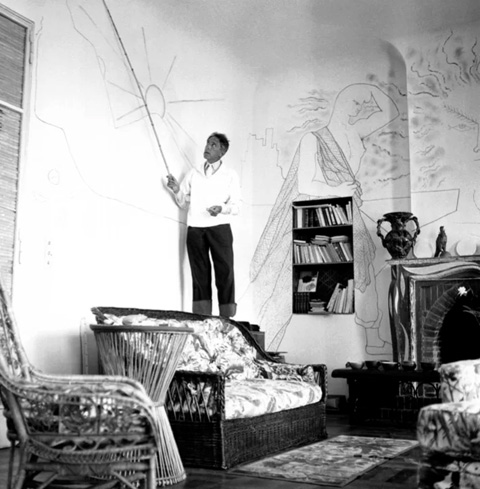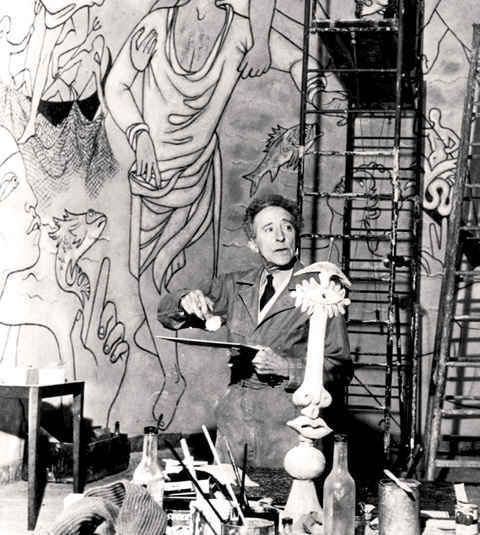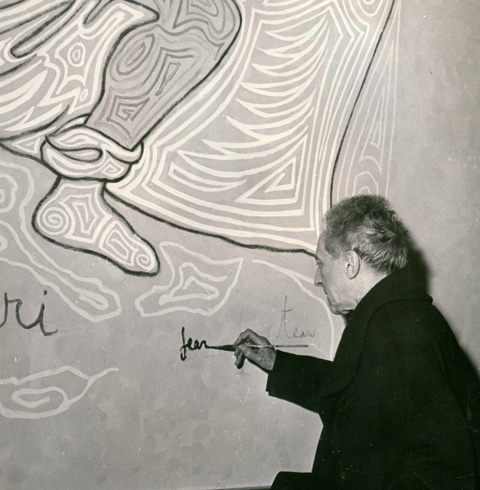Saint-Jean-Cap-Ferrat, Villefranche-sur-Mer, Menton
Saint-Jean-Cap-Ferrat, the Mediterranean pied-à-terre
From the spring of 1950, Jean Cocteau moved into the villa Santo Sospir at the invitation of his friend and patron Francine Weisweiller. The magnificent villa, located near the tip of the Cap Ferrat peninsula, near Nice, offered the artist an idyllic setting with a breathtaking view of the Mediterranean. Cocteau was welcomed there as a distinguished guest and a member of the family in his own right.
In this happy and convivial atmosphere, he began to trace large motifs on the walls of the rooms of the villa, with his hostess’s enthusiastic: “During the whole summer of 1950, I worked on ladders. An old Italian craftsman prepared powders for me that we diluted in raw milk […] The walls were not to be covered — we had to draw on their skin. This is why I treated the murals with lines, with the few colours that highlight tattoos. Santo Sospir is a tattooed villa.”

One of these imposing works, laid on the walls of Francine Weisweiller’s bedroom, depicts a mythological scene: Actaeon, a hunter and Apollo’s grandson, is changed into a deer for spying on the goddess Artemis who had been bathing naked. The painter Édouard Mac’Avoy came to the villa to paint a portrait of Cocteau and represented the mural alongside its creator on his canvas.
Villefranche-sur-Mer, the place of “personal mythology”
Villefranche-sur-Mer is a small port nestled in the bay framed by Cap Ferrat to the east and Nice to the west. Cocteau knew the place well, having spent several months there at the Welcome Hotel during the 1920s, during which he composed several poems, plays and series of drawings which hold a major position in his body of work.
Thus, when in 1952 his friend Albert Lorent suggested that he decorate the Saint-Pierre chapel, located on the port near the Welcome hotel, Cocteau accepted and, despite many setbacks, made it another of the mural art masterpieces that demonstrate his talent on the French Riviera. It was also in Villefranche that he met a couple of potters, Philippe Madeline and Marie-Madeleine Jolly, with whom he explored the art of ceramics until his death. “It was in Villefranche-sur-Mer that I finally found my personal mythology”, he said.

The series of drawings known as the Innamorati, produced in 1961, represents a couple dressed in traditional attire of the French Riviera — a young man wearing the pocket cap of Mediterranean fishermen and a young woman wearing the capeline, a large straw hat. Both figure in a setting reminiscent of a Mediterranean port; the small church which appears in the background of some of the drawings is singularly reminiscent of the rounded apse of the Saint-Pierre chapel in Villefranche decorated by Cocteau, as seen from the sea.
Menton, the artistic testament
In Menton, Jean Cocteau continued his work of monumental decoration with the wedding hall, for which he invented a new meandering graphic style. But it was also in Menton that Jean Cocteau was offered to create the first museum devoted to him, during his lifetime, in the disused fort at the port. Touched by this homage, the artist threw himself into the restoration and then the decoration of the place, which he saw as an instrument for passing down his art to future generations. The selection of works which constitutes the original collection of the Bastion museum offers a representative scope of this extremely prolific thirteen-year period that Cocteau spent on the French Riviera.

Liens externes :
Cocteau and Villefranche on the website of the town of Villefranche-sur-Mer